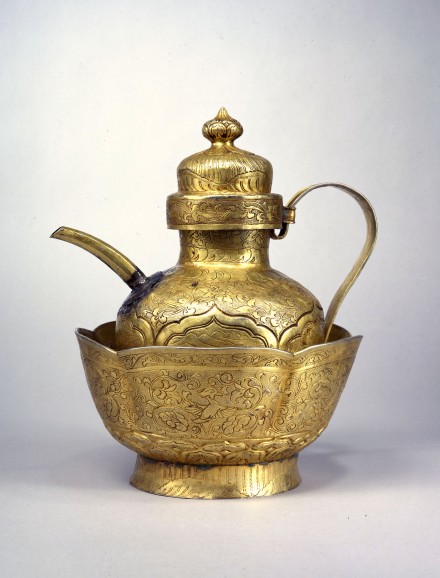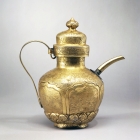J.J. Lally & Co., Oriental Art / New York City, New York
MenuPast Exhibition
Chinese Porcelain and Silver in the Song Dynasty
March 18 - April 8, 2002

12.
A GILDED SILVER COVERED EWER AND WARMING BASIN
Five Dynasties/Northern Song Dynasty, A.D. 10th century
the ewer elaborately engraved with five large petal-shaped panels each enclosing a different scene of figures in a landscape including an immortal riding on the back of a large fish, a soldier bowing to a woman in court dress, a man carrying a pennant and another with a sword together approaching a bearer who has laid down his carrying pole, a figure with a hoe over his shoulder striding away from a serpent cut into two pieces on the ground, and a man with arms outstretched in vigorous pursuit of a running tiger, all below a frieze of foliate scroll pattern interspersed with parrots on ring-matte grounds engraved on the shoulders, the cylindrical neck decorated with a double collar of overlapping petal motifs below further foliate scroll on ring-punched grounds, the pagoda-shaped cover with a wide loop attaching it to the arched strap handle which is decorated with lozenge motifs, opposite a slender curving faceted spout rising from a silver florette, the base of the vessel with a double band of overlapping petal motifs in rounded relief interspersed with clustered stamens at the edges, and the circular foot engraved with undulating water lily motifs as a continuous pattern, the domed cover decorated with the same water lily pattern and with overlapping petal motifs continuing over the bud-shaped knop; the basin with matching repoussé petal motifs around the high ring foot and rounded base below the main frieze of parrots with wings displayed amidst exotic foliate scroll on ring-punched grounds, the sides divided into five petal-lobes by deep grooves and the rim of corresponding outline, the interior engraved with a pair of carp swimming on either side of a small 'pearl' amidst stylized waves, the rim and exterior of the basin plated in gold, and the ewer gilded all over, showing black tarnish or corrosion of a different metal used around the base of the spout, the underside of the basin and the flat bottom of the foot of the ewer each scratched with an hourglass-shaped mark to indicate that they are from the same set, and the inner edge of the foot of the basin incised with four characters, the first two characters may be read as qi liang, indicating a weight of seven liang, the other characters are indecipherable.
Height of ewer and basin overall 8 5⁄8 inches (22 cm)
A Yueyao covered ewer of very similar form, incised with a continuous figural scene, excavated in 1981 in the western district of Beijing, is illustrated in Zhongguo Taoci Quanji: Tang and Wudai, (The Complete Works of Chinese Ceramics: Tang and Five Dynasties), Shanghai, 2000, Vol. 6, no. 153 and described in the caption on p. 253 as one of the finest of all Five Dynasties period Yue ware ceramics in the world. Another green glazed Five Dynasties period ewer of similar form was excavated in 1975 Zhenjian county, Jiangsu province, and is illustrated op.cit., no.147, with full description on p. 251.
An octagonal silver ewer and matching warming basin engraved with floral design excavated in 1978 from a hoard found at a site dated to the Liao dynasty at Balin Youqi in Ju Ud Meng, Inner Mongolia, are illustrated in Wenwu, No. 5, 1980, pl. 5, nos. 3-4 and in line drawings on p. 48, nos. 4-5. The same ewer and basin are illustrated in Zhongguo Meishu Quanji (The Great Treasury of Chinese Fine Arts), Vol. 10, Gongyi Meishu Bian (Works of Art and Craft), Beijing, 1987, p.59, nos. 120-121, with full description on p. 34.
Compare also the gilded silver jar decorated in a very similar style and technique with figures in landscape scenes within four large petal-shaped panels, excavated in 1987 from the crypt of Famen temple, Fufeng county, Shaanxi province, which was included in the special exhibition from China shown at the British Museum, autumn 1999, and illustrated in the catalogue entitled Gilded Dragons: Buried Treasures from China's Golden Ages, p. 157, no. 114, where the author states that the scenes have been given a Buddhist interpretation by some scholars, but goes on to say that their exact meaning is not certain and they might equally well be interpreted as depictions of Daoist stories or Confucian tales of filial piety.
Additional Images (Touch to enlarge)
12.
A GILDED SILVER COVERED EWER AND WARMING BASIN
Five Dynasties/Northern Song Dynasty, A.D. 10th century
Height of ewer and basin overall 8 5⁄8 inches (22 cm)
